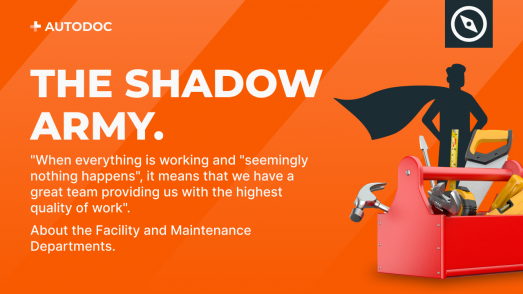Fast & Steady. How to innovate in large companies

The year was 2001, and Apple was largely known as an expensive computer manufacturer. In October that year, the perceptions and the reality of the company was about to change. On October 23, 2001, Apple announced the release of a mind-blowing MP3 player called the iPod that could store 1,000 songs. There were other competitors making MP3 players at the time, but nothing like this!
This was the turning point for Apple. Today, many innovations and even industries can be traced back to this day. The iPod led to the creation of podcasts, revolutionised the music streaming business, and, perhaps most importantly, laid the foundation for the introduction of the iPhone some six years later. If we think about it, a company the size of Apple released three iconic product innovations in the span of a decade: the iPod, the iPhone, and the iPad.
While everyone likes to think they are Apple, the fundamental truth is that most companies are not. They lack the visionary leadership of someone like Steve Jobs, the brand value of Apple, or the money required to invest in R&D. However, there is a lot we can learn from Apple’s approach to corporate innovation.
Disrupt your own business
One of the biggest challenges that large successful companies face is the fear of putting themselves out of business, like Apple did to some extent – the iPhone could be seen as a substitute for the PC, which was their main source of revenue at that point in time. There are notorious examples of companies that literally invented the innovations that would ultimately put them out of business. This is why large corporations are usually not great at innovation, they are too afraid to compete against themselves.
A few decades ago, Kodak was the biggest name in the consumer photography market. At some point, employees came up with a well-intentioned, groundbreaking innovation that allowed consumers to take photographs without needing to use rolls of film. The idea of going to a market with a camera that required no film was, from the point of view of Kodak leaders, a bad one. Why would a company sell a product that eliminated the need to buy its own flagship product and primary source of revenue?
What Kodak learned, the hard way, was that people did not buy rolls of film because they wanted to, but rather because they had no other alternative for taking photographs of their vacations and capturing memories. The minute a better, more convenient solution became available, Kodak was doomed.
So why is innovation critical for large companies? Simply because if you don’t disrupt yourself, someone else will! The best way to protect your business is not to see innovation as a threat to your current business model, but as an investment to ensure the survival of your business in the future.
Build a culture of innovation
In both cases, the challenge was not the ability of the company to innovate. Both Apple and Kodak were able to deliver innovative products. In most situations, the biggest roadblock to innovation is the company culture itself.
Having visionary leaders like Steve Jobs obviously makes it easier, but it’s not a mandatory requirement. Company management may, at a minimum, show openness towards employees’ ideas and foster innovation within the company.
Companies need to understand that there is a clear difference between having an idea and being able to implement it. While the conception of and the ability to execute ideas will ultimately determine success, innovation should be recognised and rewarded regardless of the outcome.
A company where any employee is incentivised to bring ideas to life is a company much closer to being able to innovate and disrupt itself.

Make innovation part of your business
So how can companies avoid turning into a Kodak tragedy and instead become a success story like Apple? On top of fostering a culture of innovation, companies need to define strategies and procedures that ensure that ideas and work efforts reach the right levels of decision making.
There are multiple ways to build innovation in large companies. While some can be considered more organic, others will be perceived as more purposeful. In any case, the goal is the same: to improve, change, or add value to the company’s services or product mix.
- Here are some examples on how to nurture innovation within a large company:
A) Allow employees to allocate part of their schedule to work on projects that are unrelated to their specific line of work. This works especially well in software companies and allows employees to work on ideas of their own or collaborate with colleagues on other innovative ideas.
B) Intrapreneurship and corporate venture programmes create a well-established process that enables, promotes, and invests in employees’ ideas. It’s a more structured and intentional approach than the previous one. However, it may feel less organic or more forced.
C) Mergers and acquisitions, and venture capital funds are another way for large companies to innovate. This may be considered the least appealing way to build a culture of innovation within the company. However, if we think of innovation as a vehicle to disrupt your business, then sometimes it may be the only way to catch up and get ahead of the competition and the market.

Ideally, companies should have strategies for all three of these approaches. Regardless of the mix that you choose to use or are able to invest in, the biggest challenge is to know what to do when you see a good idea and turn it into a great business opportunity.
Fail fast, invest for the long run
Another challenge for large companies is the speed at which they make decisions. As the size of the company grows, decision-making becomes more bureaucratic with more levels of approval and increased difficulty to access appropriate levels of decision-making.
In large companies, innovation will require the adoption of startup-like decision-making processes, otherwise the opportunity may be missed because people give up on the idea, leave to do it themselves, or someone else does it. For this reason, investment decisions need to be made quickly.
When it comes to investing, corporations have a critical competitive advantage over startups: they have money. A profitable company with one billion in revenue can afford to spend 5 million a year financing innovative ideas. When investing in innovation, large corporations should be prepared to finance viable ideas for multiple years before they start turning a profit.
Being prepared to make a long-term investment should also be followed by close scrutiny of its progress and the continuous evaluation of its viability. While some ideas may look great on paper, it is not uncommon, once you start developing, to realise that the idea won’t work or will be just too expensive. Companies need to be prepared to cut their losses as soon as they realise something will not work – avoid the sunk cost fallacy. Similarly to investment decisions, divestment decisions should be made quickly and objectively.
Key takeaways
Innovation is a great way for companies to ensure their future. Large corporations struggle to innovate due to a lack of innovation promotion programmes and a culture that does not encourage employees to bring their ideas forward. In some cases, in large companies, innovation can be perceived as a threat to the business rather than an opportunity to ensure its survival in the future.
In order to avoid this trap, large corporations should promote a culture of innovation among their employees by rewarding and recognising them and creating formal programmes to tap into the company’s innovative potential.
When it’s time to make decisions about innovative investments, large companies need to abandon their old ways of working and be nimble and dynamic. Make investment decisions quickly, finance them well, and be patient to see the results. If and when there are signs that the idea is not viable, divest accordingly and cut your losses.
Not all innovations will see the light of day, but for large corporations, one of them may become their main source of profit further down the line. This is why innovation is so important!
Author: Joao Campos, Head of Product ATD PRO, Delivery, Returns.
Related stories

THE SHADOW ARMY - CONSTANTLY IN MOTION
The human body is a powerful mechanism for the most important life processes. Staying fit and active, and keeping the body in good condition has been ...

From Love To Hate And Back Again. Who Data Engineers Are And How To Become One
First steps and typical problems you are likely to face in your journey to becoming a data engineer First of all, you need to understand the role ...
